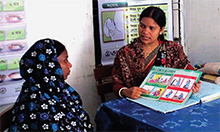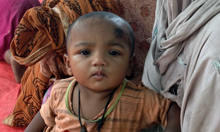A Retrospective Analysis from Bangladesh
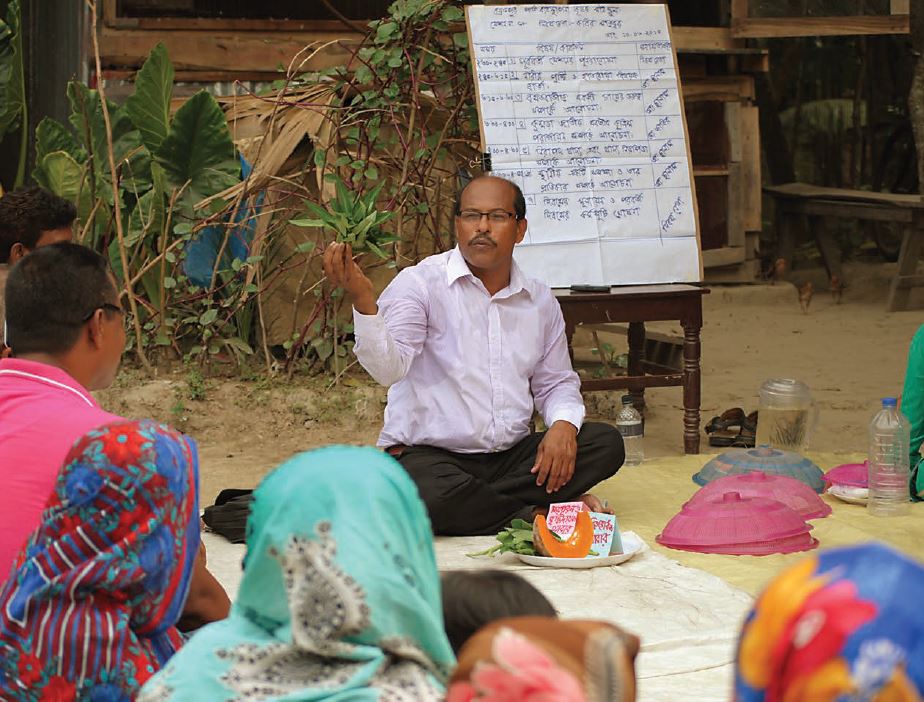
The Importance of Engaging Frontline Agriculture Workers
High-impact nutrition practices cannot be adopted and sustained by a given population simply by increasing knowledge or awareness. Many complex and contextual factors influence everyday decisions to consider, try, adopt and/or reject, and ultimately internalize and sustain a given behavior. Therefore, a sustained change in a nutrition-related behavior is unlikely to be achieved through a single activity or channel targeting a single subset of the population (such as pregnant and lactating women), introduced in a single period in time. Similarly, the decisions and steps surrounding the adoption of behaviors are often non-linear, involving multiple feedback loops across time and necessitating multifaceted interventions that help to either support or reinforce an individual’s adoption of a behavior or promote a social change that makes testing or sustaining a behavior possible.
SPRING in Bangladesh partners with government health and agriculture staff to reach pregnant and lactating women (PLW) and children under two through numerous contact points in a variety of settings and through a range of interventions over a sustained period of time. Our comprehensive, behavior-centered approach to social and behavior change communication (SBCC) comprises three strategic elements: coordination, capacity development, and community engagement (Communication for Change [C-Change] Project 2012; Pettigrew et al. 2009). Our strategy embraces the recommendations of the 2013 Lancet nutrition series, which concluded that a multi-sectoral approach, including scaled-up, proven nutrition-specific and nutrition-sensitive interventions, was needed to achieve global targets for reducing undernutrition (The Lancet 2013).
In 2012, SPRING began supporting the Government of Bangladesh’s Ministry of Agriculture (MOA) by designing a two-day training curriculum that focused on delivering tailored nutrition messages through a channel that traditionally did not provide messages on nutrition: the Department of Agricultural Extension (DAE). Sub-Assistant Agricultural Officers (SAAO) are the frontline government agricultural staff of the DAE. As field-level professional leaders, they play a vital role in disseminating agricultural innovations and practices among farmers. Studies have shown that frontline workers are a crucial source of information on health and nutrition (Sunguya et al. 2013; Pelto et al. 2004; Bhandari et al. 2005; Black et al. 2008). We build the capacity of SAAOs and support the Government of Bangladesh (GOB) in the frontline implementation of nutrition services through training, regular feedback loops (i.e., coordination meetings), and joint supportive supervision with government supervisors. Through this innovative approach of engaging SAAOs as a new cadre of frontline staff, SPRING has expanded the multi-sectoral response to addressing malnutrition by building the capacity of agriculture workers to deliver health and nutrition messages.
SPRING/Bangladesh works in the USAID Feed the Future zones of Barisal and Khulna, in 9 districts and 40 upazilas (sub-districts) covering 373 unions and approximately 125,000 pregnant and lactating women.
We develop the capacity of Government of Bangladesh health and agricultural workers and community agents, improving the ability of these frontline staff to deliver nutrition services and provide nutrition and hygiene counseling at a variety of contact points for pregnant and lactating women and children under two.

Member of Parliament Talukder Md. Younus visiting a SPRING stall at the Barisal Agriculture Fair." width="300" height="220" class="image-sidebar_right">
SBCC for ENA/EHA Framework
SPRING has adopted the essential nutrition and hygiene actions (ENA/EHA) framework for its multi-sectoral programmatic approach. This framework outlines a set of evidence-based interventions to improve SBCC for nutrition practices during the critical 1,000 days between pregnancy and two years of age (John Snow, Inc., 2014; World Health Organization 2013). Based on a “nutrition through the life cycle” approach, the framework defines the right action to be taken by the right person at the right time in the 3life cycle. These actions help improve adolescent nutrition, women’s nutrition during pregnancy and lactation, breastfeeding and complementary feeding practices, nutritional care of sick and malnourished children, control of anemia, vitamin A supplementation, calcium supplementation, and iodine deficiencies. In addition, the framework delivers a complementary set of evidence-based practices related to food hygiene, handwashing, and access to a water source near cooking areas and latrines. The framework emphasizes a multi-channel, multi-contact approach, using consistent, repeated messaging and support through various activities and mechanisms.
Our SBCC framework promotes the adoption of essential nutrition and hygiene practices by individuals, households, groups, and communities. Combining coordination, capacity development, and community engagement, the framework offers clear guidance for improving the nutrition of PLW and children under age two. Although we are also utilizing more traditional channels to reach PLW, such as farmer nutrition schools and the Ministry of Health and Family Welfare, our collaboration with the DAE allows us to reach other community members, such as husbands and mothers-in-law, as additional channels for effecting change in the household. It is important to note that the traditional extension service approach of DAE is a type of SBCC that is also designed to transform behavior.
Figure 1. SPRING/Bangladesh Social and Behavior Change Communication Framework
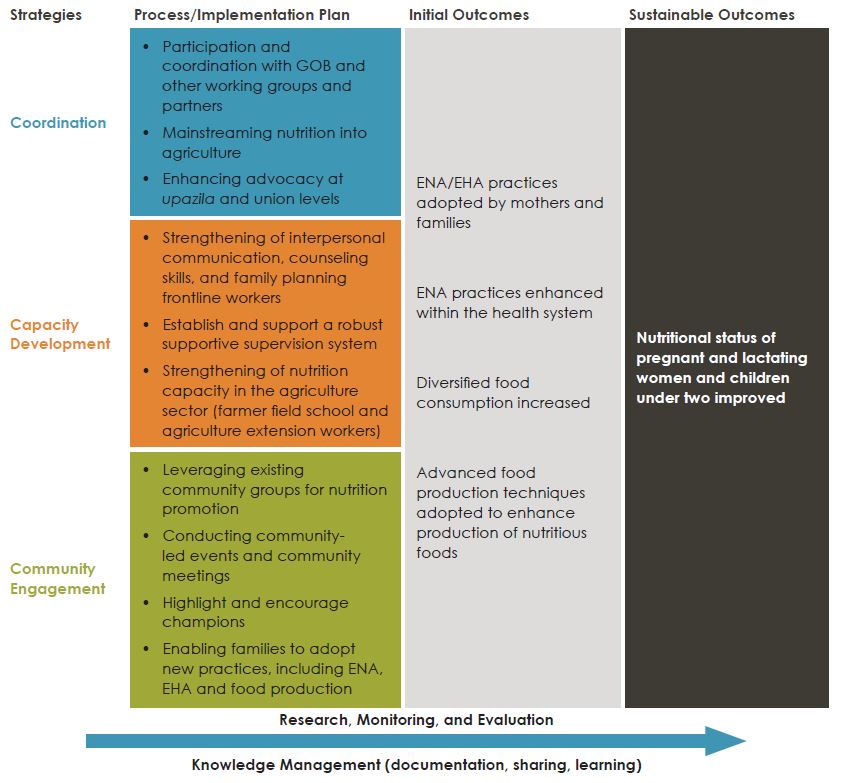
Elements of the Framework
Coordination
SPRING mainstreams nutrition into agriculture through its work with the DAE. The DAE’s SAAOs work in a specific geographic area or “block” (a block covers on average 900 rural families) at the union level. They report to the Upazila Agricultural Office (UAO) and are responsible for disseminating information related to agriculture at the block level. SPRING coordinates with this cadre of staff as an additional channel for disseminating important ENA/EHA messages into the community.
Capacity Development
Capacity development requires face-to-face dialogue with individuals or groups to inform, motivate, problem-solve, or plan, with the objective of promoting and sustaining behavior change. SPRING/Bangladesh builds the capacity of MOA staff in two ways: training and supportive supervision. We provide training to improve their technical knowledge and improve the SAAOs’ ability to clearly and effectively deliver quality messages on nutrition and hygiene. We emphasize supportive supervision via routine monitoring and feedback with government supervisors (i.e., UAOs). Regular on-the-job feedback provides MOA staff with immediate suggestions on areas where they may be able to improve their skills and capacity. SPRING staff also join in the DAE’s regular monthly review meetings, where they advocate for nutrition practices and review progress. SPRING added a nutrition agenda item to these meetings, which typically include discussion on the progress of nutrition messaging by SAAOs, planning, observations made during supportive supervision, involvement of the DAE supervisor in supportive supervision visits, barriers, enabling factors, and other relevant issues. SPRING has worked with the DAE to establish a mechanism that ensures nutrition will remain on the agenda beyond the project’s expiration.
SPRING placed emphasis on linking nutrition messages with practical activities (e.g., producing nutritious food at the homestead level and handwashing) by providing intensive training and counseling to rural families. Trainings included strengthening counseling skills for adopting ENA/EHA and instructions on how to use our low-cost hand-washing technology, the tippy tap. Trainers conducted two-day training using a curriculum developed by SPRING for SAAOs, who then included the promotion of nutrition and hygiene practices within their normal extension work. Trained SAAOs reported using ENA/EHA messages during routine community-based group meetings and said the additional workload associated with the new nutrition and hygiene content is not only acceptable, but very much welcome.
Community Engagement
Community engagement encourages institutions; community networks; and social, civic, and religious groups to demand progress toward a development objective. SPRING’s community engagement includes the DAE’s farmer groups and agriculture fairs.
SPRING has trained hundreds of DAE staff, which means that ENA/EHA messages are being disseminated to thousands of men and women in farmer groups. This type of community engagementhelpsensurethatthousandsmorepeopleinSPRING’s working area are provided with important messages on nutrition and hygiene and is helping to mobilize communities around these topics. We also took part in a number of agriculture fairs organized by the MOA at the upazila level to help disseminate messages on nutrition and hand washing, specifically through the use of tippy taps, and to encourage people to produce nutritious vegetables in their homesteads for consumption. SAAOs and the UAOs also participated in World Breastfeeding Week and Global Handwashing Day, among other activities.
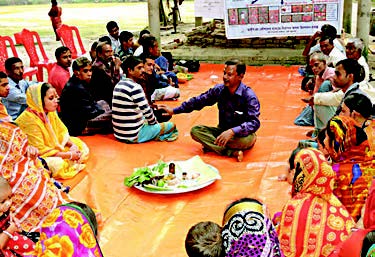
“I enjoy motivating our targeted household to grow nutritious food around the year. I feel that women have much confidence now on the messages I am conveying [to] them. Afterwards, they are practicing that ideal behavior at the household significantly which makes me proud.”
— Mst. Nurunnahar, Sub-Assistant Agricultural Officer, Babuganj Upazila
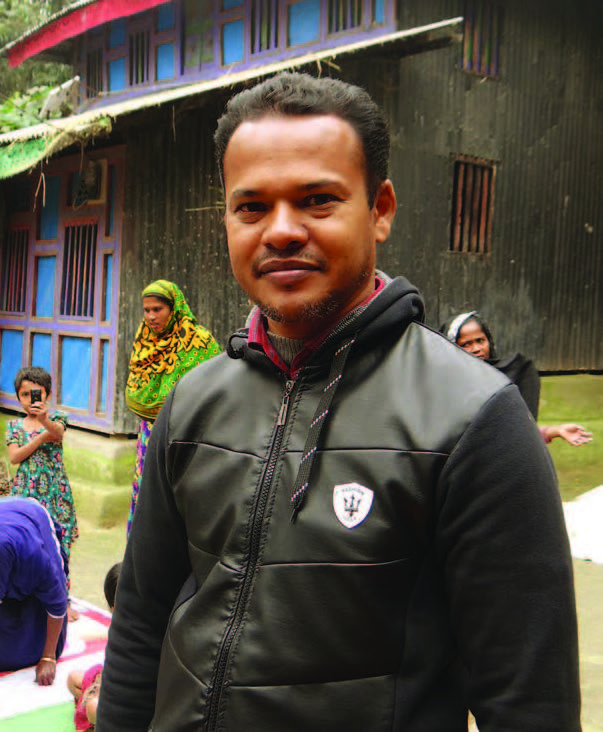
Voice From a Farmer Group
“The engagement of my participants during my sessions whenever I talk about what kind of nutrition is important to their health makes me feel happy. I enjoy teaching them about hygiene practices and the use of tippy taps. I try to make them even more engaged by doing ice breaking at first then asking questions regarding their food consumption.”
— Moniruzzaman, Sub-Assistant Agricultural Officer
Step-by-Step Implementation
Development of training curriculum
In 2012, SPRING/Bangladesh introduced The Community Worker’s Guide to train community workers, especially non-health government staff, on how to promote recommended nutrition and hygiene practices when meeting with their community members. The guide explains nutrition messages in a less technical way tailored to non-heath staff and complements the information they are providing on agricultural practices. The two-day training curriculum focuses on facilitation and negotiation to help community workers complement information on agricultural practices by introducing nutrition themes and encouraging families to adopt nutrition and hygiene practices for PLW and children under two. The community workers can select which topics they will promote at each session, which allows for flexibility and adaptability in their normal extension work.
Provide support and resources
In addition to providing training to community workers, SPRING/Bangladesh collaborated with the National Nutrition Services to develop job aids, such as a dietary diversity poster for pregnant women and a tippy-tap brochure, that are supplied to frontline MOA staff. These materials have been formally endorsed by the GOB.
Conduct practical training on ENA/EHA at all levels
SPRING/Bangladesh works with MOA staff to address knowledge gaps through supportive supervision, refresher trainings, mentoring,and coaching on ENA/EHA. MOA staff members use what they have learned to provide nutrition and hygiene messages and services during routine farmer group meetings and during community visits. Training by SPRING complements ongoing government initiatives, especially in relation to enhancing agricultural production and other community and national events.
Figure 2. Feedback Process for Capacity Building and In-Service Training
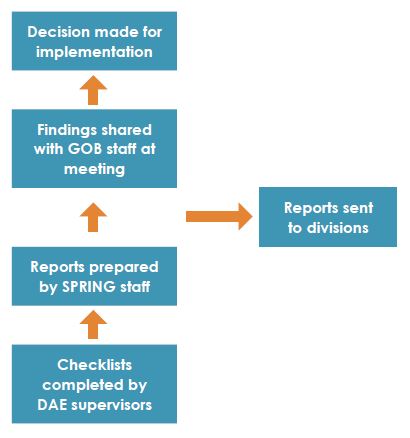
Guidance that builds capacity
Supportive supervision is a process of guiding, helping, and encouraging staff members at their place of work to improve their knowledge, skills, and performance and thus meet defined performance standards.
Supportive supervision teams, composed of a DAE supervisor and SPRING staff, use a checklist to assess the SAAO’s knowledge and the quality of nutrition information he or she is providing. The data they collect and observations from their follow-up coordination meetings and supportive supervision visits help guide the SAAOs in their work. The graphic below illustrates the process. This guidance strengthens the capacity of both SAAOs and their supervisors. SPRING staff and GOB supervisory-level staff jointly visit farmer group sessions to support extension agents and observe their communication with farmers, their nutrition messages, their use of SBCC materials, their training in handwashing and tippy taps, and their record keeping and follow-up. Based on their observations, supervisors can provide frontline workers with relevant guidance and suggestions to build their capacity and improve their nutrition messages.
Each month SPRING aggregates and analyzes the recorded data to identify any systemic weaknesses. If gaps are identified, supervisors can take action to address them. The data collected from the frontline DAE staff include details on how many pregnant and lactating women attended their sessions, which ENA/EHA messages were provided, and other details related to the organization and management of the sessions, including completion of checklists, regularity of sessions, and submission of reports.
Benefits of Supportive Supervision
- Creates and supports an environment of continuous learning
- Supports professional and personal growth of staff
- Improves staff communication
- Increases confidence
- Improves job satisfaction
- Enhances quality of practice
Challenges of Supportive Supervision
- There is an insufficient number of GOB supervisors to conduct supportive supervision due to vacancies.
- Among the available supervisors, it was at times difficult for SPRING to coordinate with them, given their busy schedules.
Results from March 2012 through September 2016
Since March 2012, SPRING/Bangladesh has mobilized individuals and communities around nutrition by drawing on government agriculture extension staff to catalyze change around nutrition and hygiene through targeted trainings.
- We provided over 3,000 supportive supervision visits to nearly 1,000 DAE staff.
- We trained more than 1,000 agriculture staff across SPRING’s 40 working upazilas in Barisal and Khulna divisions between March 2012 and September 2015, every year providing a refresher training. These same UAOs and SAAOs also received refresher training in 2014, 2015, and 2016.
- Agriculture staff trained by SPRING recorded 771,516 contacts with male and female farmers (in addition to PLW) through their ongoing farmer groups.
Figure 3. DAE Staff Trained by SPRING
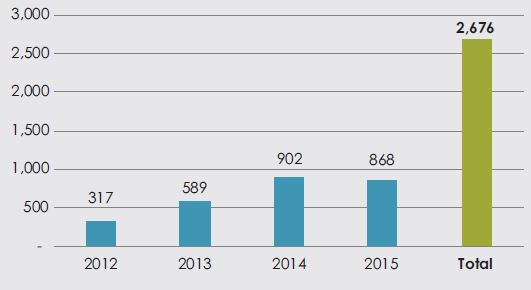
Figure 4. Contacts Made on Nutrition by SAAOs through Farmer Group Meetings
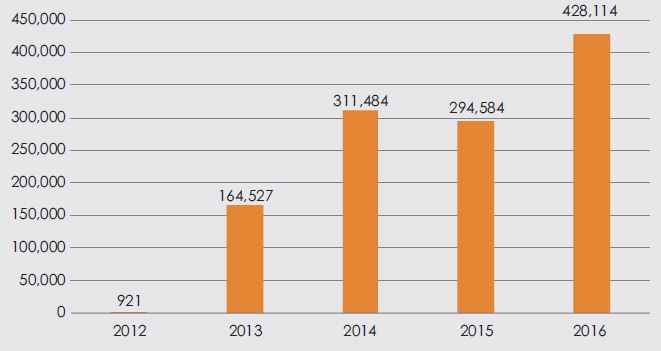
Conclusion
SPRING/Bangladesh has shown how collaboration and coordination among various government departments can contribute to better nutrition. This multi-channel approach multiplies the effect of the ENA/EHA framework and fosters behavior change around nutrition and hygiene at many different points. Although frontline MOA staff may have seemed like an unlikely nutrition partner at first, they have been enthusiastic about incorporating health messages into their work in rural communities across Bangladesh.
SPRING/Bangladesh has demonstrated that a multi-channel approach that includes support to the Ministry of Agriculture, used across a wide geographical area, is not only feasible but can also be successful in reaching a large number of people. We have used the Government’s own contact points and identified discreet areas of opportunity within the system to rapidly scale up ENA/EHA. The consistency of our efforts to improve nutrition counseling among supervisory and frontline agriculture workers in all upazilas to improve nutrition counseling has been critical to the program’s success
About SPRING/Bangladesh
Funded by the U.S. Agency for International Development, SPRING has worked in Bangladesh since 2012 to decrease undernutrition among women and children by focusing on the 1,000-day window of opportunity among PLW and children under two. One major component of the project is to support the Government of Bangladesh’s Ministry of Agriculture by providing training and supportive supervision to frontline agriculture extension agents who include nutrition and hygiene topics in their farmer group sessions.
References
Communications for Change [C-Change} Project. 2012. Social and Behavior Change Communication Framework. Washington, DC: C-Change Project.
John Snow, Inc. 2014. Understanding the Essential Nutrition Actions (ENA) Framework. Arlington, VA and Washington, DC: John Snow, Inc., and CORE Group. http://www.coregroup.org/storage/Understanding_ENA.pdf
The Lancet. 2013. “Maternal and Child Nutrition Series.” The Lancet. http://www.thelancet.com/series/maternal-and-child-nutrition
Pettigrew, Andrew, Ewan Ferlie, and Lorna McKee. 2009. “Shaping Strategic Change—The Case of the NHS in the 1980s.” Public Money & Management. Vol 12, Issue. 3. Taylor & Francis Online. http://www.tandfonline.com/doi/abs/10.1080/09540969209387719
World Health Organization. 2013. Essential Nutrition Actions. Improving Maternal, Newborn, Infant and Young Child Health and Nutrition. Geneva, Switzerland: World Health Organization. http://www.who.int/nutrition/publications/ infantfeeding/essential_nutrition_actions/en/
